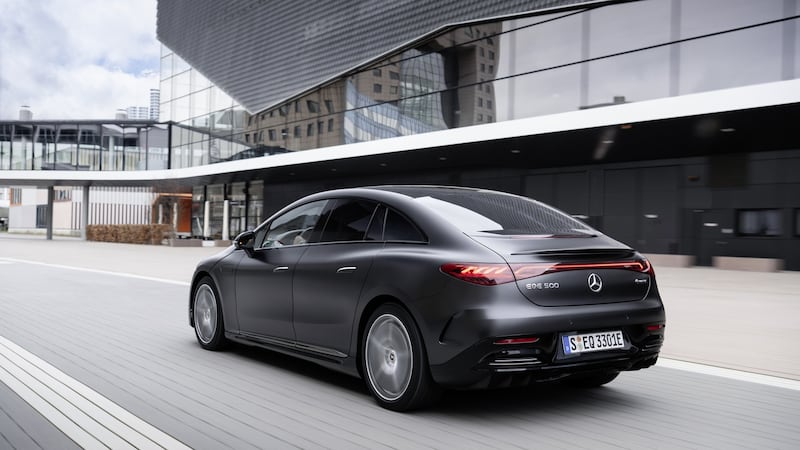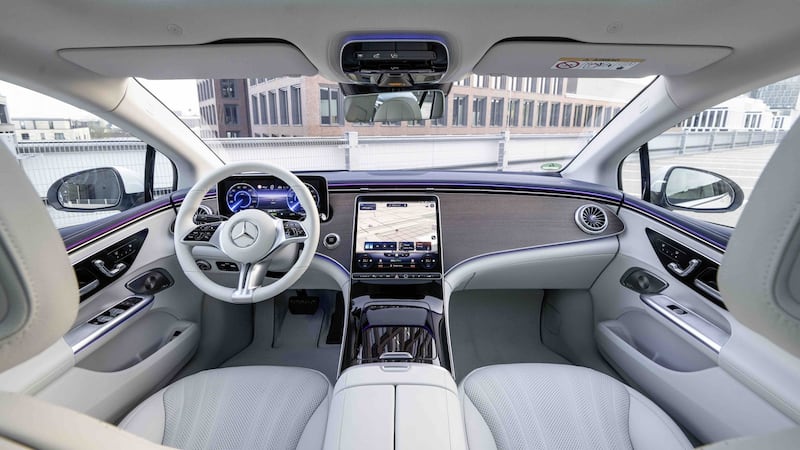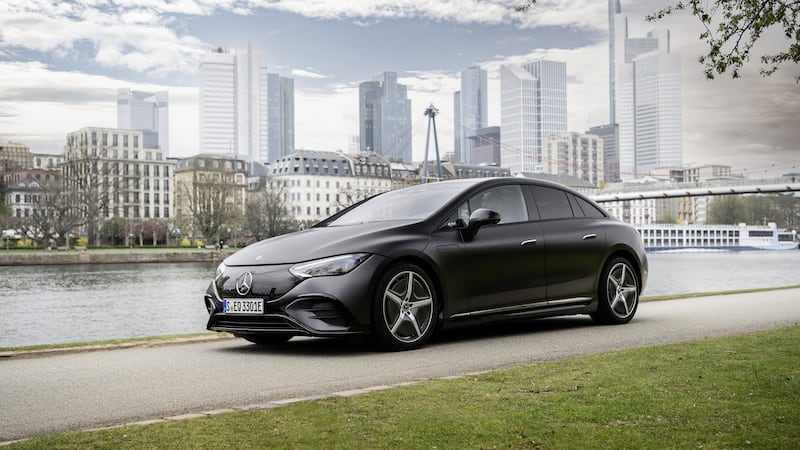When we first drove the new super-luxury Mercedes EQS electric model (the all-electric equivalent to the flagship S-Class), we were impressed with its sepulchral refinement and suspension as soft as a Labrador puppy's fluff.
However, Merc’s all-electric flagship was not without its flaws, chiefly a very odd braking system that takes a lot of acclimating to, and a sense that you’re never not aware of its vast size. At times, it can feel like driving a silent, luxuriously appointed aircraft carrier.
Well, here’s the good news - the new EQE, an E-Class-sized electric executive saloon, based on the same platform and box of electric bits as the EQS, feels more like one of the Tom-Cruise-Equipped fighters you’d fly off that same aircraft carrier. It’s far more nimble and agile than the big EQS, and is far more entertaining to drive.
There are some trade-offs, but electric range is quite simply not one of them. Although coming up around 20kWh shy of the EQS’ battery capacity, the EQE still has 100kWh total power, and 90kWh net power to play with. That translates into a one-charge range of as much as 641km. And that’s a believable range, too. That slightly amorphous, ‘one-bow’ body shape may not be the sexiest on the road, but it pays off in aerodynamic terms.

Range
Even with some very brisk acceleration runs, some time on the motorway, and a good bit of driving on twisty country roads, we could barely make a dent in the EQE’s range, and it was still showing an available 530km on a battery out of which we’d drained one quarter. Most cars struggle to hit that kind of figure with a full charge.
When you’re out and about, that battery can charge at speeds of up to 170kW - a little slower than the EQS’ 200kW (and a long way behind Audi’s 270kW) , but still good enough to add around 250km of extra range in as little as 15-minutes if you can find a high-powered charger that’s both (a) working and (b) unoccupied. Good luck with that…
The EQE 350+ uses a single electric motor, driving the rear wheels, and developing 292hp and 565Nm of torque, so performance is better than brisk. Stamp on the throttle (not that there’s any fuel-air flow to throttle anymore…) and you can hit 100km/h in just 6.4 seconds.
Performance does tail off a little as your speed rises, but the motor always seems to have some in reserve when you need it. It’s a well-judged balance between performance and electric economy (we averaged 19.5kWh/100km compared to Merc’s claim of 15.7-19.3kWh/100km) although when you’re in E for eco mode, the throttle response becomes annoyingly sticky, so you’re probably better sticking to comfort.
Engaging
Or Sport mode perhaps, because the EQE is actually properly engaging to drive. Unlike the EQS with its somewhat mute and distant steering, the EQE feels (pun alert…) properly plugged in. The steering is sharp and responsive, and that low aero-look nose tucks tightly into corners. The EQE is a mere 300mm shorter than the EQS, and is actually a fraction wider, but thanks to that steering, it feels about half the size on an enjoyable road.
The brakes are a little better too. Whereas you'll have the heart put crossways in you by the EQS' brakes on first acquaintance, the EQE's do feel a little more positive. That said, you'll still want to have the brake energy recuperation setting dialled up to its maximum, which you do by tapping the left-hand 'gearshift' paddle behind the steering wheel. Quite why it doesn't default to the max setting, given how much of the car's overall braking relies on it, is something of a Stuttgart mystery for now.
Where the EQE is well behind the EQS is in its ride quality, but that is somewhat version-specific. Our EQE 350+ test car was running on steel springs and conventional dampers, but full air suspension is an (expensive…) option. Worth it? Possibly - for the most part, the steel-suspended EQE rides comfortably, but occasionally it will drop a wheel into a rut or pothole with an unruly bang and crash.
Space
The haughty EQS would never lower itself to such a lack of decorum. The EQE is also, of course, much less spacious than its bigger brother. It’s still fairly roomy in the back, but tall passengers will find that swoopy roof brings the car’s headlining close to their own.
The boot is also rather small - 430-litres isn’t bad, but it’s well behind what’s on offer from the regular E-Class, and the EQE lacks the useful fastback boot of the EQS, as it’s a traditional four-door-separate-boot saloon.

Up front though, all is well - great seats, clear digital instruments, and a big central touchscreen that’s fairly easy to find your way around, and not overly-distracting when driving. You can, optionally, have the same 55-inch full-width ‘Hypercreen’ digital dashboard as in the EQS, but to be honest, I wouldn’t bother.
The standard layout is so well-judged, and the bigger screen is likely to be wildly distracting, and a second-and-third mortgage to fix if it breaks. Helpfully, the EQE does carry over some delightful design details from the EQS, such as the jet-turbine-style air vents, and the gorgeous wood veneer for the bits of the dashboard that aren’t screen.
Other neat additions include optional rear-wheel steering (which allows this big EQE to turn tighter than an A-Class hatchback), and a Young Driver software programme which limits the car’s speed and power if your firstborn is behind the wheel.
Final hurdle
There is a final hurdle, though, and it’s cost. At minimum, the EQS costs €85,980, and with only a few optional extras, our test car clocked in at a chunky €106,404. Yikes. Then again, a comparable E-Class isn’t cheap these days either, with prices starting at a minimum of €61,685 and once you start adding in higher-spec engines and options, you wouldn’t be long hitting the EQE’s base price. Equally, it wasn’t so long ago that we test-drove a mid-spec C-Class diesel with a €70,000 price tag, so suddenly the EQE doesn’t look like such bad value.

Want to spend more? That’s easy - there’s a AMG EQE 43 version available for €120,180 with a 475hp powertrain, and that will also be joined in due course by and EQE 500 and an AMG EQE 53 (which will have a whopping 686hp…).
A few years ago, we were asking why no-one had stepped up to challenge the Tesla Model 3's dominance of the mid-size four-door electric car market.
Well, Merc has decided to skip over that by creating an E-Class-sized EV that has Tesla beaten for range (Model 3) or price (Model S - if you can even get one) and beats both for quality, comfort, and refinement. Even without a shortage of new cars arriving, we suspect that there would be queues around the block for this one. Yes, even at that price.












